perl常用模块
学习使用Perl进行网络编程和系统管理
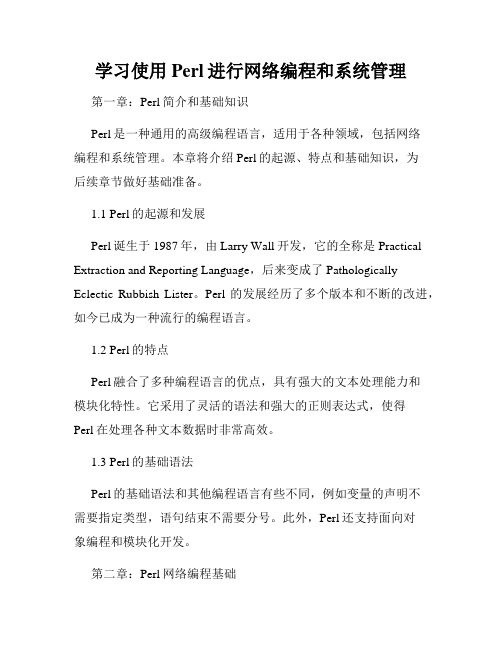
学习使用Perl进行网络编程和系统管理第一章:Perl简介和基础知识Perl是一种通用的高级编程语言,适用于各种领域,包括网络编程和系统管理。
本章将介绍Perl的起源、特点和基础知识,为后续章节做好基础准备。
1.1 Perl的起源和发展Perl诞生于1987年,由Larry Wall开发,它的全称是Practical Extraction and Reporting Language,后来变成了Pathologically Eclectic Rubbish Lister。
Perl的发展经历了多个版本和不断的改进,如今已成为一种流行的编程语言。
1.2 Perl的特点Perl融合了多种编程语言的优点,具有强大的文本处理能力和模块化特性。
它采用了灵活的语法和强大的正则表达式,使得Perl在处理各种文本数据时非常高效。
1.3 Perl的基础语法Perl的基础语法和其他编程语言有些不同,例如变量的声明不需要指定类型,语句结束不需要分号。
此外,Perl还支持面向对象编程和模块化开发。
第二章:Perl网络编程基础网络编程是Perl的一个重要应用领域,在本章中,将介绍Perl 的网络编程基础知识,包括Socket编程、TCP/IP协议和常用网络模块的使用。
2.1 Socket编程Socket是一种用于网络通信的编程接口,Perl提供了Socket模块,可以方便地进行Socket编程。
本节将介绍Socket编程的基本概念和使用方法。
2.2 TCP/IP协议TCP/IP是互联网使用的基本协议,Perl能够通过Socket编程来实现TCP/IP协议的通信。
本节将介绍TCP/IP协议的基本原理和Perl中相关函数的使用。
2.3 常用网络模块Perl提供了许多网络编程相关的模块,如Net::FTP、Net::Telnet 等。
本节将介绍这些常用网络模块的功能和使用方法,帮助读者更好地进行网络编程。
第三章:Perl系统管理基础除了网络编程,Perl还可以用于系统管理任务,如系统监控、日志分析等。
perl包

perl 包我们经常落到使用拷贝和粘贴(ICP-I Copy & Paste)的陷阱里,而如果一个循环或者一个子过程就足够了,(注:这是伪懒惰的一种形式)那么这时候我们实际上应该定义一个更高层次的抽象。
但是,有些家伙却走向另外一个极端,定义了一层又一层的高层抽象,而这个时候他们应该用拷贝和粘贴。
(注:这是伪傲慢的一种形式。
)不过,通常来讲,我们大多数人都应该考虑使用更多的抽象。
落在中间的是那些对抽象深度有平衡观念的人,不过他们马上就开始写它们自己的抽象层,而这个时候它们应该重用现有的代码。
(注:你也许已经猜到了——这是为急燥。
不过,如果你准备推倒重来,那么你至少应该发明一种更好的东西。
)如果你准备做任何这样的事情,那么你都应该坐下来想想,怎样做才能从长远来看对你和你的邻居最有好处。
如果你准备把你的创造力引擎作用到一小块代码里,那么为什么不把这个你还要居住的这个世界变得更美好一些呢?(即使你的目的只是为了程序的成功,那你就要确信你的程序能够符合社会生态学的要求。
)朝着生态编程的第一步是:不要在公园里乱丢垃圾(译注:否则砸到小朋友...或者花花草草...:)。
当你写一段代码的时候,考虑一下给这些代码自己的名字空间,这样你的变量和函数就不会把别人的变量和函数搞砸了,反之亦然。
名字空间有点象你的家,你的家里想怎么乱都行,只要你保持你的外部界面对其他公民来说是适度文明的就可以了。
在 Perl 里,一个名字空间叫一个包。
包提供了基本的制作块,在它上面构造更高级的概念,比如模块和类等。
和“家”的说法相似,“包”的说法也有一些模糊。
包独立于文件。
你可以在一个文件里有许多包,或者是一个包跨越多个文件,就好象你的家可以是在一座大楼里面的小小的顶楼(如果你是一个穷困潦倒的艺术家),或者你的家也可以由好多建筑构成(比如你的名字叫伊丽沙白女王)。
但家的常见大小就是一座建筑,而包通常也是一个文件大,Perl 给那些想把一个包放到一个文件里的人们提供了一些特殊的帮助,条件只是你愿意给文件和包相同的名字并且使用一个 .pm 的扩展名,pm 是“perl module” 的缩写。
PERL DBI

• DBI应用程序的架构 : 应用程序的架构
API是应用程序Perl-脚本(编程)接口。调用接口和变量由DBI提供到 perl脚本。 ‘Switch’是用来为实际的执行调度DBI方法调用到恰当的驱动器的一段 代码。Switch还负责动态加载驱动器,错误检查/处理以及其他职责。 驱动器负责实施支持给定类型的数据库。驱动器包含使用相应引擎的私 有接口函数编写的DBI方法的实现。
成功建立student表:
插入数据:
DBI在mysql的具体应用 在 的具体应用
一个简单的DBI脚本 脚本 一个简单的
1 #!usr/bin/perl 2 use DBI; 调用DBI模块 3 use strict; 4 my $dsn=“DBI:mysql:database=test;hostname=localhost”; 数据源 5 my $user_name=“root”; 用户名 6 my $password=“123”; 密码 7 my ($dbh,$sth); 数据库句柄和执行语句句柄 8 my (@ary); 存放查询数据数组 9 $dbh=DBI->connect($dsn,$user_name,$password,{RaiseError=>1});数据库连接 10 $sth=$dbh->prepare(“select * from student ”); 准备执行查询 11 $sth->execute(); 执行查询 12 while(@ary=$sth->fetchrow_array()){ 13 print join("\t",@ary),"\n"; 14 } 提取数据,打印查询结果 15 $sth->finish; 断开执行语句句柄 16 $dbh->disconnect(); 断开数据库连接 17 exit(0); ~
Perl模块安装及cpan初始设置

Perl 模块安装及cpan 初始设置2009-11-13 08:30:33标签:perl关于Perl 模块Authen::SASL 的安装方法。
Perl 中的正则表达式Perl(格式和字符串处理)在Apache服务器上运行mod_perl...perl 文件读写详细说明简单笔记一下关于Apache支持perl 以及m...关于perl学习的2个函数的问题!Perl 应用举例(PDF电子书下载)用perl调用系统命令来实现IPC$远程猜解...Perl 动态网页CGI入门1- HelloWorld ...用Perl语句来代替常用的操作系统命令前段时间研究Perl 通过smtp 发送邮件。
其中smtp验证的时候需要Authen::SASL 模块。
以下转载安装的方式:安装Perl模块Authen::SASL (optional Perl module for SVN::Notify)# wget/CPAN/authors/id/G/GB/GBARR/Authen-SASL-2.12.tar.gz# chmod a+x Authen-SASL-2.10.tar.gz# tar zxvf Authen-SASL-2.10.tar.gz# cd Authen-SASL-2.10# perl Makefile.pl==> Auto-install the 1 optional module(s) from CPAN? [n] y // 首次执行的时候,需要CPAN 初始化设置。
==> Auto-install the 1 optional module(s) from CPAN? [n] y //之后一路按回车# make test# make install //安装完成#############################################CPAN 初始设置Posted in perl by wanguan2000 on the 02月13th, 2009在安装Koha的时候,需要提前安装perl的相关模块,这里用到了CPAN,刚开始不知道是什么东东,现把Google来的东西整理在此,以作备份。
perl常用实例

perl常用实例(实用版)目录1.Perl 简介2.Perl 常用实例2.1 文本处理2.2 数据分析2.3 网络编程2.4 Web 开发正文【Perl 简介】Perl(Practical Extraction and Reporting Language)是一种高级脚本语言,主要用于文本处理、数据分析、网络编程和 Web 开发等领域。
它具有丰富的语法和强大的功能,可以简化各种复杂任务的实现。
Perl 最早由 Larry Wall 在 1987 年开发,现在已成为 IT 行业广泛使用的编程语言之一。
【Perl 常用实例】【2.1 文本处理】Perl 在文本处理方面的应用非常广泛,例如:- 文件读写:Perl 可以方便地对文件进行读取和写入操作,实现文件的备份、合并等操作。
- 字符串处理:Perl 提供了丰富的字符串操作函数,可以实现字符串的匹配、替换、连接等功能。
- 正则表达式:Perl 的正则表达式功能强大,可以方便地对文本进行查找、替换等操作。
【2.2 数据分析】Perl 在数据分析方面的应用也非常广泛,例如:- 数据库连接:Perl 可以连接各种数据库,进行数据的增删改查操作。
- 数据处理:Perl 可以对数据进行排序、筛选、分组等操作,实现数据的分析和处理。
- 数据可视化:Perl 可以生成各种图表,实现数据的可视化展示。
【2.3 网络编程】Perl 在网络编程方面的应用也非常丰富,例如:- Socket 编程:Perl 可以通过 Socket 实现客户端和服务器的通信,实现网络应用的开发。
- HTTP 编程:Perl 可以实现 HTTP 服务器,进行 Web 应用的开发。
- FTP 编程:Perl 可以实现 FTP 客户端和服务器,进行文件的上传和下载。
【2.4 Web 开发】Perl 在 Web 开发方面的应用也非常广泛,例如:- CGI 编程:Perl 可以通过 CGI 实现与 Web 服务器的交互,生成动态网页。
Perl 与数学
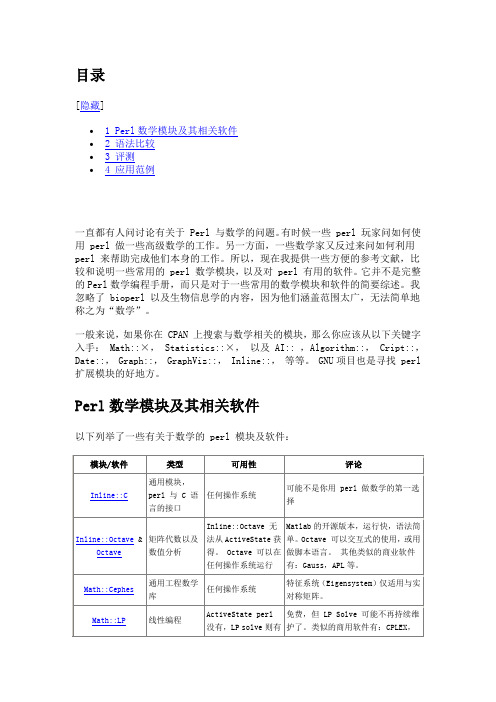
目录[隐藏]∙ 1 Perl数学模块及其相关软件∙ 2 语法比较∙ 3 评测∙ 4 应用范例一直都有人问讨论有关于 Perl 与数学的问题。
有时候一些 perl 玩家问如何使用 perl 做一些高级数学的工作。
另一方面,一些数学家又反过来问如何利用perl 来帮助完成他们本身的工作。
所以,现在我提供一些方便的参考文献,比较和说明一些常用的 perl 数学模块,以及对 perl 有用的软件。
它并不是完整的Perl数学编程手册,而只是对于一些常用的数学模块和软件的简要综述。
我忽略了 bioperl 以及生物信息学的内容,因为他们涵盖范围太广,无法简单地称之为“数学”。
一般来说,如果你在 CPAN 上搜索与数学相关的模块,那么你应该从以下关键字入手: Math::×, Statistics::×,以及 AI:: ,Algorithm::, Cript::,Date::, Graph::, GraphViz::, Inline::,等等。
GNU项目也是寻找 perl 扩展模块的好地方。
Perl数学模块及其相关软件以下列举了一些有关于数学的 perl 模块及软件:语法比较我们来比较一下这些模块和软件的语法。
我们以运算一个2×2矩阵与一个向量的乘积为例,以下是它们各自的语法。
仅就数学上来说,以上这些模块和软件的语法看起来都相当简洁。
不过 Octave 和 R 比 perl 还是要好懂的多了。
许多数学语言的一个突出特点是它们的“向量操作”以及“下标操作”。
具个例子来讲,例如现在我们要从一个矩阵中,提取一个子矩阵。
向量的串行运算是一个非常不错的功能. 考虑一下下面的有关于 R 的源码:> vec = 1:10> vec[1] 1 2 3 4 5 6 7 8 9 10> vec %% 2[1] 1 0 1 0 1 0 1 0 1 0> vec[vec %% 2 == 1][1] 1 3 5 7 9> vec[vec %% 2 == 1] + 1[1] 2 4 6 8 10我们刚才在前面也提到了 Pari,但它只是一个自成体系的模块。
perl基本语法

perl基本语法Perl 基本语法by Jian Lee最近在研究openSUSE 的OBS (编译系统),其中很多部分用到Perl。
而且自己也感到有必要学点Perl,当有一点其他程序语言的基础,再学一门语言,入门还是非常简单的。
Perl 在 GNU/Linux 上应用如此广泛,很多地方替换 shell 脚本会更灵活优秀高效,学习它也很有必要。
本文是学习时的笔记,多是语法使用示例,没有什么说明。
拟研究 OBS 时,依据某个应用再写一篇 Perl 应用教程。
标量数字字符串数字和字符串之间的自动转换Perl 内嵌的警告标量变量print 输出if 控制结构Boolean 值用户的输入 <STDIN>chomp 操作while 控制结构undef 值defined 函数列表和数组qw 简写列表赋值pop 和 push 操作shift 和 unshift 操作字符串中引用数组foreach 控制结构最常用的默认变量: $_ reverse 操作sort 操作标量和列表上下文子程序使用 sub 定义子程序调用子程序参数my 变量使用 strict Pragma省略 &输入和输出从标准输入设备输入从 <> 输入调用参数输出到标准输出设备使用 printf 格式化输出数组和 printf句柄(即文件描述符)文件句柄的打开Bad 文件句柄关闭文件句柄严重错误和 die使用文件句柄哈希什么是哈希哈希元素的存取哈希函数正则表达式简单的模式正则表达式的应用使用 m// 匹配可选的修饰符锚定匹配变量使用正则表达式处理文件使用 s/// 进行替换split 操作join 函数列表上下文中的 m//更强大的正则表达式更多控制结构unless 控制结构until 控制结构表达式修饰符The Naked Block 控制结构elsif 语句自增和自减 (同C)for 控制结构 (同C)循环控制逻辑操作符 && 和 ||文件校验文件检测操作stat 和 lstat 函数localtime 函数位操作目录操作在目录树上移动GlobbingGlobbing 的替换语法目录句柄删除文件 unlink重命名文件链接文件创建和删除目录修改权限改变所有者改变时间戳字符串和排序使用索引寻找子串使用 substr 操作子串使用 sprintf 格式化数据进程管理system 函数exec 函数环境变量使用反引号得到输出像文件句柄一样处理进程fork 函数发送和接受信号Perl 模块查找安装模块使用简单的模块一些高级的 Perl 技术利用 eval 捕捉错误标量标量是Perl 中最简单的数据类型。
perl脚本基础总结
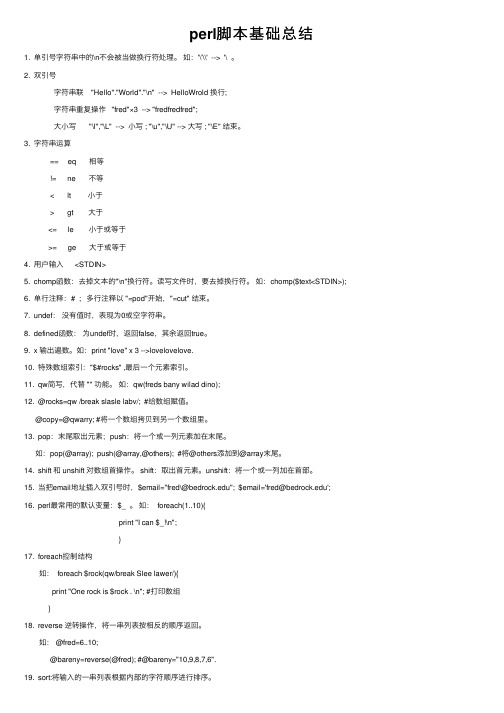
perl脚本基础总结1. 单引号字符串中的\n不会被当做换⾏符处理。
如:'\'\\' --> '\ 。
2. 双引号字符串联 "Hello"."World"."\n" --> HelloWrold 换⾏;字符串重复操作 "fred"×3 --> "fredfredfred";⼤⼩写 "\l","\L" --> ⼩写 ; "\u","\U" --> ⼤写 ; "\E" 结束。
3. 字符串运算== eq 相等!= ne 不等< lt ⼩于> gt ⼤于<= le ⼩于或等于>= ge ⼤于或等于4. ⽤户输⼊ <STDIN>5. chomp函数:去掉⽂本的"\n"换⾏符。
读写⽂件时,要去掉换⾏符。
如:chomp($text<STDIN>);6. 单⾏注释:# ; 多⾏注释以 "=pod"开始,"=cut" 结束。
7. undef:没有值时,表现为0或空字符串。
8. defined函数:为undef时,返回false,其余返回true。
9. x 输出遍数。
如:print "love" x 3 -->lovelovelove.10. 特殊数组索引:"$#rocks" ,最后⼀个元素索引。
11. qw简写,代替 "" 功能。
如:qw(freds bany wilad dino);12. @rocks=qw /break slasle labv/; #给数组赋值。
@copy=@qwarry; #将⼀个数组拷贝到另⼀个数组⾥。
《学习PERL》课件

Perl支持面向对象编程,可以定义类 和对象,支持继承和多态等面向对象
的特性。
强大的文本处理能力
Perl拥有丰富的文本处理函数,能够 高效地处理字符串、正则表达式等文 本数据。
丰富的第三方库
Perl拥有庞大的第三方库和模块,涵 盖了各种领域,方便程序员快速开发 。
Perl的应用领域
Web开发
更新操作
更新哈希表或关联数组中的 键值对。
引用和动态内存分配
引用
通过引用实现变量之间的关联和共享。
引用计数
了解引用计数机制,掌握内存管理技巧。
动态内存分配
在运行时动态分配内存空间。
内存管理
合理管理内存,避免内存泄漏和浪费。
CHAPTER 04
Perl模块和包
CPAN和模块安装
01
CPAN(Comprehensive Perl Archive Network)是Perl模块和 包的官方仓库,提供了数千个Perl模块和包供用户下载和安装。
02
Perl的目的是使程序员能够快 速、高效地编写脚本,处理文 本文件和系统任务。
03
随着时间的推移,Perl逐渐发 展成为一种功能强大的编程语 言,广泛应用于Web开发、系 统自动化、网络编程等领域。
Perl的特点和优势
语法灵活
Perl的语法融合了多种编程语言的特性 ,使得Perl既易于阅读又易于编写。
02
使用CPAN工具,如cpanminus或cpan,可以轻松安装所 需的Perl模块和包。
03
安装过程中可能需要管理员权限,确保在安装前了解所需 的权限和依赖关系。
使用模块和包
01
Perl模块和包提供了可重用的代码库,可以方便地用 于开发应用程序。
perl 使用方法

perl 使用方法Perl是一种高级编程语言,它被广泛应用于Web开发、系统管理、数据处理等领域。
本文将介绍Perl的使用方法,帮助读者快速上手。
一、Perl的安装与配置1. 下载Perl的最新版本,官方网站提供了多种操作系统的安装包。
2. 双击安装包,按照提示完成安装过程。
3. 配置环境变量,将Perl的安装路径添加到系统的PATH变量中。
二、Perl的基本语法1. 注释:在Perl中,以"#"开头的行表示注释,不会被解释执行。
2. 变量:Perl中的变量使用"$"符号进行标识,可以存储各种类型的数据。
3. 标量:标量变量存储单个值,可以是字符串、数字等。
4. 数组:数组变量存储一组值,使用"@"符号进行标识,可以通过下标访问其中的元素。
5. 哈希:哈希变量存储键值对,使用"%"符号进行标识,可以通过键访问对应的值。
6. 控制结构:Perl支持if-else、for、foreach、while等常见的控制结构,用于实现条件判断和循环操作。
三、Perl的字符串处理1. 字符串连接:使用"."符号可以将两个字符串连接起来。
2. 字符串截取:使用substr函数可以截取字符串的一部分。
3. 字符串替换:使用s///操作符可以替换字符串中的某个子串。
4. 字符串分割:使用split函数可以将一个字符串按照指定的分隔符拆分成多个子串。
5. 字符串匹配:使用正则表达式可以进行强大的字符串匹配操作。
四、Perl的文件操作1. 打开文件:使用open函数可以打开一个文件,并返回文件句柄。
2. 读取文件:使用<>操作符可以从文件句柄中读取一行内容。
3. 写入文件:使用print函数可以向文件句柄写入内容。
4. 关闭文件:使用close函数可以关闭文件句柄。
五、Perl的模块和包管理1. 模块安装:Perl的CPAN(Comprehensive Perl Archive Network)提供了大量的第三方模块,可以使用cpan命令安装。
windows里如何安装perl模块

windows里如何安装perl模块我们在windows里常用的perl解释器是active perl,这个解释器是比较好的,因为他自带一个ppm(perl package manager),通常我们可以在cmd中执行ppm,然后就会弹出图形界面,从这个界面我们可以查看已经安装了哪些模块。
perl最大的代码共享空间就是cpan(/),我们一般可以到那搜索和下载perl模块。
下面主要讲两个在cmd中安装perl模块的方法。
PPM方式优点:方面缺点:部分模块搜索不到,也就不能安装具体步骤:1,装好库,这些网站都有编译好了的模块,2,用命令安装,ppm install 模块名称具体方法如下: 添加库的方法:在cmd中运行命令ppm repo suggest (意思是给出建议添加的网站),然后将列出的网站使用命令ppm repo add 网站url (比如 ppm repo add /perl/ppm bribes )添加,全部添加完这步完成后就用模块安装命令安装.手动编译方式优点:通吃所有模块缺点:有点麻烦具体步骤:1安装编译器2设置编译器的环境变量3可能安装dmake具体方法:如下1.首先要有个c编译器,因为很多模块都是用c编写的。
推荐dev-cpp(/projects/dev-cpp/),记得要下含有mingw的就是了(不懂c,下载含有mingw的因为这个版本的bin目录里有gcc.exe等工具).1.1安装好了编译器之后,要能在cmd中以命令方式运行的话,必须要设置环境变量,将dev-cpp/bin路径加入到环境变量中,否则cmd 中无法运行相应的命令,注意加的是绝对路径。
弄完好,在cmd中运行gcc -v 显示出内容表示编译器安装成功,并且可以用命令行编译.2.编译步骤,在cpan上下载需要的模块,比如Win32::SerialPort,一般是gz格式的,用rar解压就行。
解压后在cmd中进入这个目录(简单的dos命令应该知道吧),就用常见的方法:perl Makefile.plmakemake testmake install2.1需要注意几点2.1.1具体编译步骤应该先看下模块包内的readme2.1.2用的是dev-pp编译器,故用make,vc编译器好象是nmake。
perl语言基本命令

perl语言基本命令Perl语言是一种功能强大的脚本语言,可以用于处理文本、执行系统命令以及开发Web应用等。
本文将介绍一些Perl语言的基本命令和用法。
一、输出命令1. print:用于输出字符串或变量的值。
例如:```print "Hello, Perl!\n";```2. say:与print类似,但会自动换行。
例如:```say "Hello, Perl!";```3. printf:按照指定格式输出字符串或变量的值。
例如:```my $name = "Alice";my $age = 20;printf "Name: %s, Age: %d\n", $name, $age;```二、变量命令1. my:用于声明一个局部变量。
例如:```my $name = "Bob";```2. our:用于声明一个全局变量。
例如:```our $count = 0;```3. scalar:将数组或哈希转换为标量。
例如:```my @numbers = (1, 2, 3);my $count = scalar @numbers;```4. chomp:去除字符串末尾的换行符。
例如:```my $str = "Hello, Perl!\n";chomp $str;```三、输入命令1. <STDIN>:用于从标准输入读取用户输入的数据。
例如:```print "Please enter your name: ";my $name = <STDIN>;chomp $name;print "Hello, $name!\n";```2. getc:从标准输入读取一个字符。
例如:```print "Please enter a character: ";my $char = getc;print "You entered: $char\n";```四、控制流命令1. if-else:用于条件判断。
perl常用命令

1.操作符描述lt 小于gt 大于e q 等于le小于等于g e 大于等于ne 不等于cmp 比较,返回1, 0, or -1 2.逻辑或:$a || $b 或$a or$b逻辑与:$a &&$b 或$a an d $b逻辑非:! $a或 no t $a逻辑异或:$axor $b3.表达式等效表达式$a = 1; none (bas ic as signm ent)$a -= 1;$a =$a -1;$a *=2; $a = $a * 2;$a/= 2; $a = $a / 2; $a %= 2; $a = $a % 2;$a **=2; $a = $a ** 2;$a &= 2; $a= $a& 2;$a |= 2;$a =$a |2;$a ^=2; $a = $a ^ 2;4.字符串联结和重复操作符联接: .重复:x联接且赋值(类似+=): .=例:$news tring = "p otato" . "head";$newst ring= "t" x 5;$a = "b e"; $a .= "wi tched"; #$a is now"bewi tched"5.条件操作符与C中类似,条件?值1:值2,当条件为真时取值1,为假时取值2,如:$resu lt =$var== 0? 14: 7;$re sult= 43+ ($d iviso r ==0 ? 0 : $d ivide nd /$divi sor);PE RL 5中,还可以在赋值式左边使用条件操作符来选择被赋值的变量,如: $co ndvar == 43 ? $var1: $va r2 =14; $con dvar== 43 ? $v ar1 = 14 : $var2 = 14;6.数组--列表的存贮列表存贮于数组变量中,与简单变量不同,数组变量以字符"@"打头,如: @a rray= (1, 2, 3);7.$var= <ST DIN>;@arra y = <STDIN>; #^D为结束输入的符号8.数组的输出:(1) @array = (1, 2,3); pr int (@arra y, "\n");(2) @array = (1, 2,3); pr int ("@arr ay\n");结果为:1 2 3sca lar()获得数组的元素个数9.列表/数组的长度当数组变量出现在预期简单变量出现的地方,则PERL解释器取其长度。
perl基本语法
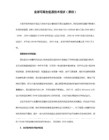
1 Scalar(纯量变量):
纯量变量是Perl里最基本的一种数据型态,它可以代表一个字符、字符串、整数、甚至浮点数,而Perl把它们都看成是一样的东东! 你甚至可以混着用,不可思议吧。例如:
# 井字号开头的后面都是批注。
# 纯量变数以$开头。
# my 是一种宣告变量的方式,它可以使变量区域化。
(7)空串,0,Undef,这三种情况都为假
例如:如下比较的结果
35 != 30+5 #假
35 == 35.0 #真
'35' eq '35.0' #假(当成字符串来比较)
'fred' lt 'barney' #假
'fred' lt 'free' #假
(17,26<<2)
(17,$var1+$var2)
($value,"Theansweris$value")
二、Perl数组--列表的存贮
列表存贮于Perl数组变量中,与简单变量不同,Perl数组变量以字符"@"打头,如:
@array=(1,2,3);
注:
(1)Perl数组变量创建时初始值为空列表:()。
$array[6]=17;#now@arrayis(1,2,3,5,"","",17)
◆Perl数组间拷贝
@result=@original;
◆用Perl数组给列表赋值
@list1=(2,3,4);
@list2=(1,@list1,5);#@list2=(1,2,3,4,5)
perl中获得文件的绝对路径

一、概述在Perl编程中,经常会涉及到获取文件的绝对路径的需求。
文件的绝对路径是文件在文件系统中的完整路径,包括了文件所在的目录和文件的名称。
获取文件的绝对路径可以帮助我们精确地定位和操作文件,因此对于文件处理和管理来说是非常重要的。
二、使用Cwd模块获取文件的绝对路径在Perl中,我们可以使用Cwd模块来获取文件的绝对路径。
Cwd模块是Perl标准库中的模块,提供了一系列用于获取当前工作目录和文件路径的函数。
下面是使用Cwd模块获取文件绝对路径的示例代码:```perluse Cwd 'abs_path';my $file = 'test.txt';my $abs_path = abs_path($file);print "文件test.txt的绝对路径是:$abs_path\n";```上面的代码首先使用use指令引入了Cwd模块,并且使用abs_path函数获取了文件test.txt的绝对路径。
abs_path函数接受一个文件名作为参数,并返回该文件的绝对路径。
三、使用File::Spec模块获取文件的绝对路径除了Cwd模块,我们还可以使用File::Spec模块来获取文件的绝对路径。
File::Spec模块提供了一系列用于处理文件名和目录名的函数,其中包括了一个catfile函数可以用来拼接路径。
下面是使用File::Spec模块获取文件绝对路径的示例代码:```perluse File::Spec;my $file = 'test.txt';my $abs_path = File::Spec->rel2abs($file);print "文件test.txt的绝对路径是:$abs_path\n";```上面的代码首先使用use指令引入了File::Spec模块,并且使用rel2abs方法获取了文件test.txt的绝对路径。
从入门到精通学习Perl编程的完整教程
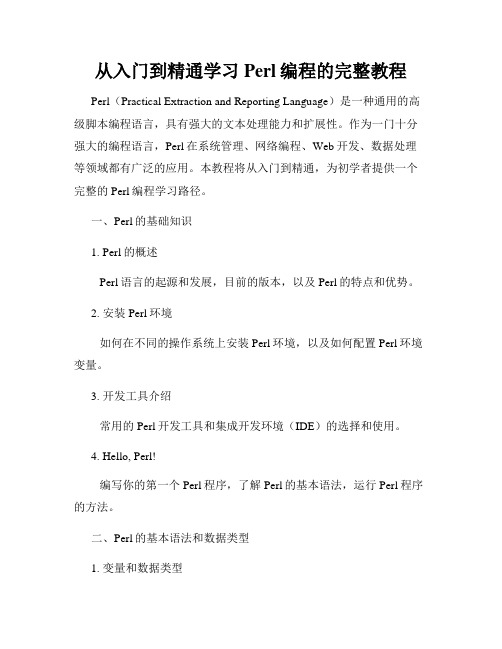
从入门到精通学习Perl编程的完整教程Perl(Practical Extraction and Reporting Language)是一种通用的高级脚本编程语言,具有强大的文本处理能力和扩展性。
作为一门十分强大的编程语言,Perl在系统管理、网络编程、Web开发、数据处理等领域都有广泛的应用。
本教程将从入门到精通,为初学者提供一个完整的Perl编程学习路径。
一、Perl的基础知识1. Perl的概述Perl语言的起源和发展,目前的版本,以及Perl的特点和优势。
2. 安装Perl环境如何在不同的操作系统上安装Perl环境,以及如何配置Perl环境变量。
3. 开发工具介绍常用的Perl开发工具和集成开发环境(IDE)的选择和使用。
4. Hello, Perl!编写你的第一个Perl程序,了解Perl的基本语法,运行Perl程序的方法。
二、Perl的基本语法和数据类型1. 变量和数据类型Perl中的变量定义和使用,标量、数组、哈希的概念和用法。
2. 运算符和表达式Perl支持的算术运算符、逻辑运算符、比较运算符和位运算符的使用。
3. 控制流语句Perl中的条件判断和循环语句,if-else语句、for循环、while循环等。
4. 常用函数和模块Perl内置的常用函数介绍和使用,以及如何使用CPAN安装和使用第三方模块。
三、Perl的高级特性1. 正则表达式正则表达式在Perl中的应用和语法,如何使用正则表达式进行文本匹配和替换。
2. 文件操作Perl中如何打开文件、读取和写入文件,如何处理文件和目录。
3. 子程序和模块如何定义和调用子程序,如何编写和使用Perl模块,提高代码的重用性和可维护性。
4. 异常处理和错误调试处理程序运行过程中可能出现的异常情况,如何进行错误调试和日志记录。
四、Perl在实际应用中的使用1. 系统管理如何使用Perl进行系统管理,包括文件管理、进程管理、系统监控等。
2. 网络编程使用Perl进行Socket编程,实现网络通信和网络应用开发。
Perl语言入门_1

当双引号括起来的字符串中间含有$符 号时,会进行变量替换 $name=”Alice“; $hello=“hello $name”; $test=“\n, \t, \007, \x63”; #变量$hello的内容为”hello Alice” 如果为单引号,则不进行替换
字符串函数
列表的操作
push和pop是在队尾进行的 shift和unshift是在队头进行的
0
1
2
3
4
5
列表的@b; @c=(1..4,@a); 数组@a的长度可以用$#a+1得到 注意数组的长度是在运行时决定的
Array related
不需要编译 运行平台:Windows, UNIX and LINUX
Perl的优点和缺点
优点:
跨平台 擅长文本处理操作 实用高效
缺点:
不擅长数学计算 不擅长实时任务 代码难读
Perl的安装
Windows平台下的Perl安装程序 在ftp搜索引擎里搜索,
ActivePerl *perl*.msi
Removing newlines
chomp($string); chomp(@list); # one element # every element
perl -ne用法

perl -ne用法摘要:1.perl -ne 用法概述2.perl -ne 用法的基本语法3.perl -ne 用法的具体示例正文:【1.perl -ne 用法概述】perl -ne 是一种在perl 语言中广泛使用的语法,尤其适用于文本处理和数据分析任务。
它的主要特点是将每一行作为输入,对每一行进行处理,然后将处理后的结果输出。
这种用法可以方便地对文本文件进行行处理,满足各种复杂需求。
【2.perl -ne 用法的基本语法】perl -ne 用法的基本语法如下:```perl -ne "code" file```其中,`code`是需要执行的perl 代码,`file`是要处理的文件。
在执行过程中,perl 会逐行读取文件内容,对每一行执行`code`中的代码,并将处理后的结果输出。
【3.perl -ne 用法的具体示例】下面是一个具体的示例,演示如何使用perl -ne 用法来处理一个文本文件:```perlperl -ne "print $_;" input.txt```这个示例中,`input.txt`是要处理的文本文件。
`print $_;`这行代码表示将每一行输入输出到屏幕上。
执行这个命令后,屏幕上会显示`input.txt`文件中的所有内容。
另一个示例,假设我们有一个名为`input.txt`的文件,其内容如下:```applebananaorange```我们可以使用perl -ne 用法来统计文件中每种水果出现的次数:```perlperl -ne "($fruit) += ($_ =~ m/($fruit)/g)? 1 : 0; END { print "$fruitt$count[$fruit]"; }" fruit count input.txt```这段代码中,我们使用了正则表达式来匹配每行中的水果名称,并使用一个哈希数组`%count`来统计每种水果出现的次数。
- 1、下载文档前请自行甄别文档内容的完整性,平台不提供额外的编辑、内容补充、找答案等附加服务。
- 2、"仅部分预览"的文档,不可在线预览部分如存在完整性等问题,可反馈申请退款(可完整预览的文档不适用该条件!)。
- 3、如文档侵犯您的权益,请联系客服反馈,我们会尽快为您处理(人工客服工作时间:9:00-18:30)。
my $timeout = 2;
my $delay = 1;
my $cmd = "ssh";
my @params = qw/202.108.xx.xx -lusername -p22/;
my $pass = "passwd";
my $exp = Expect->spawn($cmd, @params) or die "Can't spawn $cmd\n";
(13) Getopt::Std
(14) Proc::ProcessTable
(15) Shell
(16) Time::HiRes, sleep(), time()
(17) HTML::LinkExtor, links(), parse_file()
(18) Net::Telnet, open(), print(), getline()
(28) Net::IMAP::Simple, login(), mailboxes(), select(), get()...
(29) Bio::DB::GenBank, Bio::SeqIO
(30) Spreadsheet::ParseExcel
(31) Text::CSV_XS, parse(), fields(), error_input()
exit 0;
(13) Getopt::Std
#!/usr/bin/perl
use strict;
use Getopt::Std;
my %opts;
getopts("c:hv", %opts);
</servlet>
<servlet-mapping>
<servlet-name>php</servlet-name>
<url-pattern>*.php</url-pattern>
</servlet-mapping>
</web-app>
xml
my $x = XMLin($text);
use strict;
use Net::Telnet;
use constant HOST => '';
use constant USER => 'lstein';
use constant PASS => 'xyzzy';
my $telnet=Net::Telnet->new(HOST);
}
elsif($flag==0)
{
print "the two dates are identical!\n";
}
else
{
print "date2 is earlier!\n";
}
exit 0;
(9) Date::Manip, Date_Cmp()
(10) File::Find, find()
$ftp->get(FILE) or die $ftp->message;
$ftp->quit;
warn "File retrieved successfully.\n";
(2) Net::Telnet
#!/usr/bin/perl -w
# file:remoteps.pl
#!/usr/bin/perl -w
use strict;
use File::Find;
my $file = "access.log";
my $path = "/";
find(&process, $path);
sub process{ print $File::Find::dir, "$_\n" if(/$file/); }
my $sth = $dbh->prepare($sql);
$sth->execute();
while(my @array=$sth->fetchrow_array())
{
printf("%-35s", $_) foreach(@array);
print "\n";
}
$dbh -> disconnect();
(23) Term::Cap, Tgetend(), Tgoto, Tputs()
(24) HTTPD::Log::Filter
(25) Net::LDAP
(26) Net::SMTP mail(), to(), data(), datasend(), auth()
(27) MIME::Base64, encode_base64(), decode_base64()
# file: ftp_recent.pl
# Figure 6.1: Downloading a single file with Net::FTP
use Net::FTP;
use constant HOST => '';
use constant DIR => '/pub/CPAN';
#!/usr/bin/perl -w
use strict;
use Data::Dumper;
print Dumper(@INC);
print Dumper(%ENV);
exit 0;
(7) IO::Socket
#!/usr/bin/perl -w
use strict;
use IO::Socket;
(1) Net::FTP
(2) Net::Telnet
(3) LWP::Simple, get()
(4) Expect
(5) XML::Simple, XMLin()
(6) Data::Dumper, Dumper()
(7) IO::Socket
(8) Date::Manip, DateCalc(), UnixDate()
use Date::Manip;
my $date1 = "Fri Jun 6 18:31:42 GMT 2003";
my $date2 = "2003/05/06";
my $flag=&Date_Cmp($date1,$date2);
if($flag<0)
{
print "date1 is earlierip, Date_Cmp()
(10) File::Find, find()
(11) ExtUtils::Installed, new(), modules(), version()
(12) DBI, connect(), prepare(), execute(), fetchrow_array()
$exp->expect($timeout, -re=>'[Pp]assword:');
$exp->send_slow($delay, "$pass\r\n");
$exp->interact();
$exp->hard_close();
exit 0;
(5) XML::Simple, XMLin()
(37) HTML::Parser
(38) Mail::Sender
(39) Time::HiRes, gettimeofday(), usleep()
(40) Image::Magick
(41) Data::SearchReplace
(1)Net::FTP
#!/usr/bin/perl -w
#!/usr/bin/perl
use strict;
use DBI;
my $dbh = DBI->connect("dbi:mysql:dbname", 'user','passwd', '')
or die "can't connect!\n";
my $sql = qq/show variables/;
exit 0;
#用于在unix文件树结构中查找对象。
(11) ExtUtils::Installed, new(), modules(), version()
#!/usr/bin/perl
use strict;
use ExtUtils::Installed;
my $inst= ExtUtils::Installed->new();
my $url = shift || "";
my $content = get($url);
print $content;
exit 0;
#最简单方便的get网页的方法。
(4) Expect
#!/usr/bin/perl
use strict;
$telnet->login(USER,PASS);
my @lines=$telnet->cmd('ps -ef');
print @lines;
(3) LWP::Simple, get()
